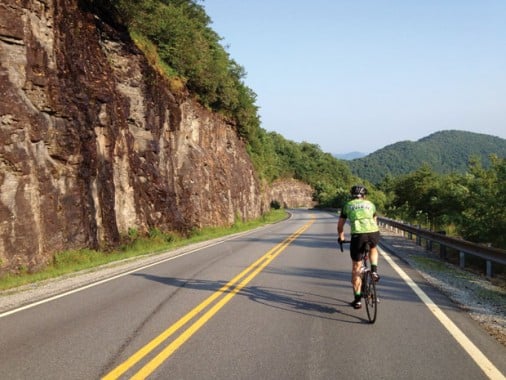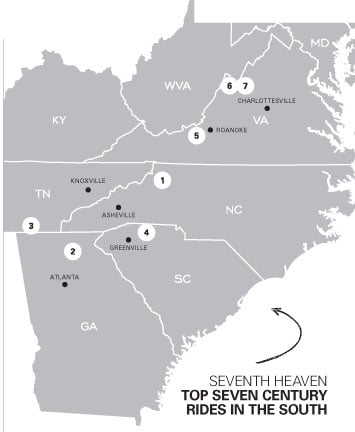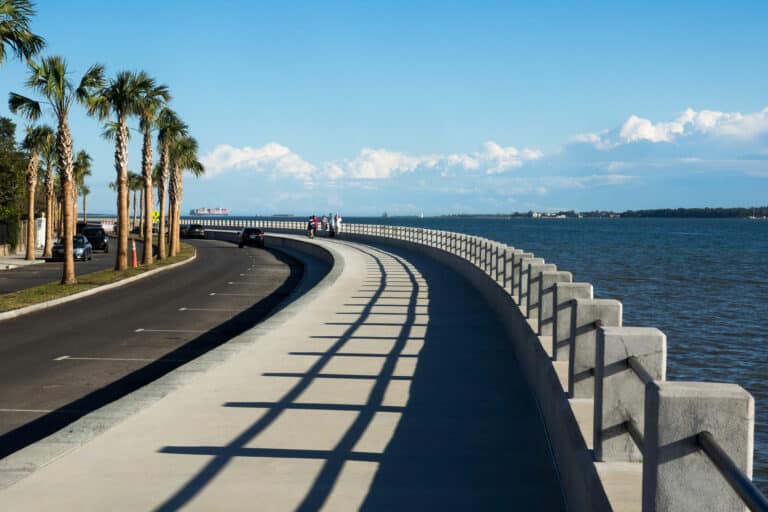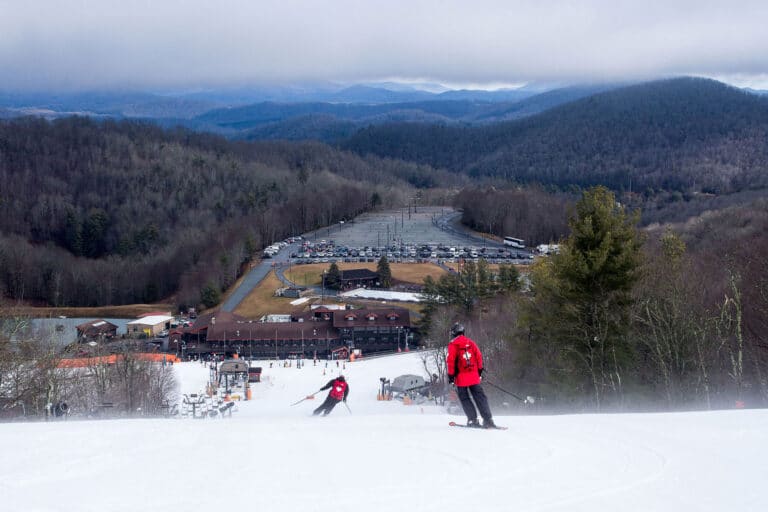Hogpen Gap is a proving ground for any cyclist in the Southeast. Aaron West/Steepclimbs.com
WHAT IS IT ABOUT TRIPLE DIGITS THAT HOLD A SPECIAL PLACE IN THE MIND OF THE ENDURANCE ATHLETE?
Joining the century club is especially challenging in the Blue Ridge, where those 100 miles usually include thousands of feet of climbing. It takes a special kind of mental fortitude to line up at the start knowing you have all that riding, all that pain, ahead of you. I guess that’s why they give you the t-shirt at the finish line.
Luckily for the masochist, the Blue Ridge is the perfect place for the 100-mile race. The elevation gains will bust your lungs, the descents will raise the hair on the back of your neck, and the scenery will bring tears to your eyes. Or maybe that’s your quad muscles in utter revolt of you spending a perfectly good Saturday in this manner.
Either way, we have compiled a guide to the toughest century rides in the Blue Ridge, so pick your poison of hellacious hills.
BLOOD, SWEAT & GEARS, Boone, NC
Elevation Gain: 9,000 ft
Toughest Climb: Snake Mountain
Shorter Options: Half Century
Lance Armstrong famously called the Boone area of North Carolina “the best area for training in the whole of the United States,” so it is fitting that one of the Southeast’s toughest century rides would be located here. Ride director Scott Nelson says in the early days of the race, they were just concerned with covering the costs of the race, now they sell out their 750 spots in a matter of hours and raise thousands of dollars for the Watauga Red Cross and other organizations. Nelson says 70 percent of riders each year have ridden the event previously, which lends an even more communal atmosphere to the event, especially for those using the race as a personal triumph.
“They’ve decided they were going to re-define themselves by doing something that pushes them. For whatever reason, a lot of people are choosing our ride to do that.”
They may be choosing Blood, Sweat, and Gears (BSG) because of its reputation for endless climbs and the beauty of the region it traverses. Riders only have four miles to warm up before the course takes a sharp turn upwards, gaining 1,000 feet over the next five miles.
“Unlike a lot of other rides, you start out climbing just a few miles in,” says century rider Aaron West. Then you go through Blowing Rock, the heart of the city, which is pretty quaint.”
But the true test of the BSG comes at the 60-mile mark and the climb up Snake Mountain. A six-mile gradual climb turns into a grueling quad-buster during the last mile, reaching grades of 20 percent.
“It gets steeper and steeper, then you get to what they call ‘The Wall,’” said West. “A lot of people walk it; they call that getting ‘snake-bit.’”
It’s not all downhill from there, but the hardest part is over. Even though this race is held in the heat of late June, over 200 volunteers turn out to make sure riders have what they need. This dedication is what makes the ride special in the eyes of Nelson, and keeps riders coming back year after year.
“Once you ride BSG, you’re part of the family,” he said.
SIX GAP CENTURY, Dahlonega, GA
Elevation Gain: 11,230 ft
Toughest Climb: Hogpen Gap
Shorter Options: 3 Gap Fifty or 35-mile Valley Ride
For the past 24 years, the Six Gap Century has been near the top of any list touting the toughest century rides in the Southeast, and for good reason. The course mirrors many of the same climbs as the Tour de Georgia, one of the main warm-ups for the pros riding in the Tour de France. American cycling great Levi Leipheimer proclaimed the Tour de Georgia’s “climbing in the mountains is the best of any North American race.”
Over its 100 miles, riders climb over six mountain gaps and gain over 11,000 feet of elevation along the way, including the signature climb over Hogpen Gap at nearly 3,500 feet above sea level.
“That’s about seven miles with an average of 10% grade with some steeper pitches,” said West. “People say that’s one of the toughest individual climbs in the Southeast.”
West says one of the major appeals of the Six Gap Century is barreling down the backside of each mountain.
“The descending is the reward for the climbing, kind of like a roller coaster.”
Because the ride takes place in late September, the weather often makes it more tolerable. Be sure to check out the annual Bike Expo that takes place in downtown Dahlonega the day before the race.
3 STATE 3 MOUNTAIN, Chattanooga, TN
Elevation Gain: 5,900 ft
Toughest Climb: Burkhalter Gap
Shorter Options: Metric Century (2 State, 1 Mountain) or Quarter Century (1 State, 0 Mountain)
During the first weekend in May for the past 25 years, cyclists have been riding one of the most lung-busting century routes in the Southeast. Like its name suggests, the 3 State 3 Mountain route winds its way through Tennessee, Alabama, and Georgia and over Suck Creek, Sand, and Lookout Mountains from its starting point in Chattanooga. The ride has had to deal with its fair share of adversity over the past few years. In 2011, tornados knocked off the last section of the Lookout Mountain climb, and controversy over rider and motorist behavior threatened the ride’s signature climb up Burkhalter Gap in 2010. With the strife behind them, however, over 2,000 riders participated in 2012.
Each of its three distinct climbs get progressively more difficult as the ride wears on. The first major climb up Suck Creek Mountain is long and gentle, averaging a 5 percent grade over seven miles. Sand Mountain is significantly more steep, but is also shorter, averaging 7 percent grade over only 2.5 miles. The crown jewel of Burkhalter Gap averages a 10 percent grade over its 2.3 miles, with sections as steep as 20 percent near the top. These mountain roads also provide some of the best scenery in the tri-state area.
ASSAULT ON MOUNT MITCHELL, Spartanburg, SC
Elevation Gain: 10,357 ft
Toughest Climb: Mount Mitchell
Shorter Options: Assault on Marion (74.2 miles)
The Assault on Mount Mitchell is one of the oldest centuries in the Blue Ridge, beginning in 1975, and for this reason is well known throughout the Southeast and the country.
“As far as challenges in the Southeast, it’s kind of the benchmark,” said West. “Even if you can argue which ones are harder, it’s always near the top of the list, if not at the top.”
The Assault is well known because of its history, but also because of its difficulty. This ride not only features a 25-mile climb to the top of Mount Mitchell, it features a 75-mile, relatively flat ride from Spartanburg to the mountain’s base. This route and climbing profile means riders have to use a little more strategy than on a normal mountain century, according to Jennifer Billstrom, who rode the Assault in 2007.
“It’s flat and fast and really fun until you get to Marion, then you’re climbing to the sky,” she said. “It wears you down quite a bit. There is such a temptation to ride it as fast as you can. It would be really easy to burn yourself out before you even start the most challenging part. You really have to pace yourself.”
Mount Mitchell marks the highest point east of the Mississippi, so a summit finish is all that much more spectacular.
“When I tell people about my rides, that’s the one that impresses them the most,” says West.
MOUNTAINS OF MISERY, Blacksburg, VA
Elevation Gain: 10,000 ft
Toughest Climb: Mountain Lake
Shorter Options: Wilderness Road Ride (various distances)
Mountains of Misery celebrated its 15th anniversary in 2012, attracting over 500 riders to its hilly route outside Blacksburg, Va. Over 10,000 feet of climbing await those willing to take on the challenge, which passes through some of the South’s most picturesque countryside.
“The entire route is absolutely beautiful; it’s very scenic from beginning to end,” said Billstrom. “It really is like riding through a postcard.”
For every beauty, there is a beast. Ride director Anne Jones says she has a unique way of warning riders who sign up for the event.
“I tell everyone that signs up, ‘I’m sorry, it’s not fun,’” she said. “There is no way you can ride that far and have that much climbing and not hurt.”
The beginning section of the course is marked by short steep ascents and descents. The climbing starts in earnest at the 60-mile mark. This is just a precursor for the ride’s signature element: the climb up to the finish at Mountain Lake. The Category-1 climb comes in the final 5 miles and averages almost 12 percent grade, with sections of 16 percent. This uphill finish is what “makes everyone cry” according to Jones. As a testament to its difficulty, race organizers have put an aid station half way up the climb, less than two miles from the finish.
The race also has great support from the surrounding community, with loads of spectators lining the climbs, bearing signs and chalking the asphalt for their favorite riders.
MOUNTAIN MAMA, Monterey, VA
Elevation Gain: 10,000 ft
Toughest Climb: Allegheny Mountain
Shorter Options: Blue Grass Valley (27 miles), Two State Short (53 miles), Two State Long (67 miles)
The Mountain Mama climbs and descends nine mountains between Virginia and West Virginia, making this one of the most rugged centuries in the Allegheny Highlands. The climbing starts right off the bat: less than 500 yards into the route, riders encounter their first significant uphill, a wake-up call at 1.5 miles at 7% grade. The Mountain Mama course is punctuated by steep and sometimes long climbs, but it’s not all an uphill battle. High speed, twisting descents and stretches along valley floors gives this ride the variety to keep riders guessing.
The Allegheny Highlands is known for its rugged terrain and elevation drops, and the Mountain Mama takes advantage. Although the route passes in the shadow of Spruce Knob, West Virginia’s highest point, this course does not lack in ascents. Over the last 20 miles, there are three major mountain climbs, including Allegheny Mountain. This is where the top tier riders separate themselves from the pack. The final five miles of the ride include a 2.5 mile climb into a thrilling 2.5 mile downhill into the finish from the top of Monterey Mountain. This final section also holds some of the best views on course; the Mountain Mama certainly saves the best for last.
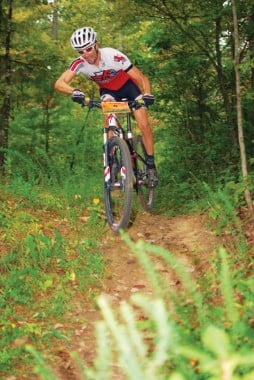
SHENANDOAH MOUNTAIN 100, Stokesville, VA
Elevation Gain: 13,000 ft
Toughest Climb: Death Climb
Shorter Options: Take the tour over 3 or 4 days.
One of the most prominent dirt centuries in the Blue Ridge is the Shenandoah 100. The race now hosts 650 riders and is part of the National Ultra Endurance Series. “It’s kind of become an annual East coast who’s who of long distance mountain biking,” says race director Chris Scott.
Beginning from the Stokesville Campground, the course winds its way mostly through George Washington National Forest. Consisting of mostly singletrack riding, with the occasional doubletrack or fire road, the course gains over 12,000 feet of elevation. Scott says the singletrack climb of Lynn Trail comes early in the race and can be a deal breaker if a rider has to walk the entire thing. Later in the race comes the Death Climb, a long slog up a fire road that can bonk any rider. One of the highlights of the race is a seven mile downhill from the high point of the race off of Little Bald Knob. The views off Chestnut Ridge also gives racers a unique feeling of remoteness, as only mountains are visible for miles. Scott says he and his crew are hoping to add more and better singletrack to the beginning of the 2012 version. Ultimately, though, it’s the festival atmosphere that drives people to show up year after year. •
Best of the Rest, More Great Centuries
Issaqueena’s Last Ride
Issaqueena’s Last Ride in South Carolina is said to trace the final escape of Creek Indian maiden Issaqueena as she fled a Cherokee war party. You could feel like you’ll never escape during this ride’s middle third. The route’s gentle terrain gives way to a steep, sustained climb up the Blue Ridge Escarpment and Whitewater Falls, where legend has Issaqueena ducking behind the falls to escape her pursuers’ clutches. This climb stretches over 10 miles and reaches grades of 14%. Issaqueena’s Last Ride also forms half of the Blue Ridge Double with the Tour de Cashiers.
Hot Doggett Century
The Hot Doggett Century ride gets its name from its signature climb over Doggett Gap, which comes relatively early in the race at mile 32. Don’t be fooled into thinking the hard part is over, however, as you still have over half of the over 9,600 feet of climbing to go before finishing in Mars Hill, NC. Add in the possibility of blistering July heat and screaming descents and this is one doozy of a ride.
Blue Ridge Breakaway
Breaking away from the pack is easy…at the beginning. This ride starts off easy with virtually flat first 50 miles, but the second half of the ride is dominated by two major peaks and 32 miles of the Blue Ridge Parkway. The views are spectacular, if you can still see straight once you get up there. Adding to riders’ misery is the always fickle BRP weather. During their first ride, cyclists even had to be evacuated due to a sudden storm.
Bridge to Bridge
The Bridge to Bridge begins in Lenoir, NC and makes its way casually around the county before getting serious in a hurry. After 50 miles of rolling hills, the course takes a sharp turn upward with a sustained 11 miles of climbing. The final leg of the race is its most painful, however, as riders follow the Blue Ridge Parkway across the beautiful Linville Viaduct before the steep slog to the top of Grandfather Mountain. The finish and a surprising amount of spectator support await those who complete this “hill of a ride.”
Tour de Cashiers
This mountain century begins and ends in Cashiers, NC and makes great use of the scenic Nanatahala and Pisgah national forests along its route. High elevation lakes and picturesque gorges make this one of the most beautiful rides in the Blue Ridge. Don’t be fooled, though, as the route includes the Walnut Creek climb: nearly 2,000 feet of elevation gain over 6 miles, half of which comes in the final 2 miles.
